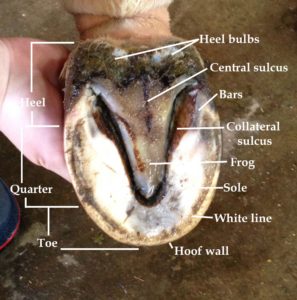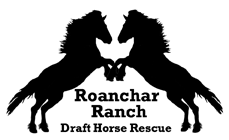If you have been around horses long enough, you have heard the saying “No hoof, no horse.” A horse’s hooves provide the foundation for a healthy partner. They need to bear weight, resist wear, absorb shock, and help with blood flow. A falter in any one of these areas can cause a horse to go lame.

Common Hoof Issues
Thrush
Thrush is a common infection of the frog of the hoof and is usually most evident in the grooves (sulci) on either side of the frog and in the central section. There are two main ways you’ll notice your horse may have thrush – sight and smell. Thrush causes black discharge to occur on and around the frog, and the discharge is accompanied by a strong, unpleasant odor. The hind feet are more often affected than the front feet and, occasionally, infection may result in a general swelling of the distal (lower) limb.
Thrush can be avoided by good stall management, and regular foot care and inspection. Clean, dry conditions and regular hoof trims avoid the development of long heel conformation and keep the frog healthy.
Quarter Crack
Quarter cracks are vertical cracks, located in the quarter of the hoof between the widest part of the foot and the heel. They can range in severity from full-thickness, penetrating cracks to “blind” cracks, which show a fault line and indicate weakness but are not opened or separated. Additionally, cracks may be irregular, with two cracks running side by side, and they can also penetrate the hoof wall at an angle.
Treatment of hoof cracks usually requires the services of an experienced farrier and/or veterinarian, not only for the preliminary treatment and stabilization, but also to help determine the reason for the hoof crack. They also can ensure that proper hoof balance is achieved through corrective and supportive shoeing.
If quarter cracks are caught early and have not penetrated the sensitive tissues within the hoof, the primary treatment will include proper trimming, thorough cleansing of the quarter crack, immobilization of the damaged area, and stabilization of the hoof wall. Sometimes, trimming the hoof properly and applying the correct shoe will solve the problem.
Hoof Bruise
The most common type of lameness is the hoof bruise. Causes of bruises can range from encounters with rocks, snow, or ice on the trail, to the continual pounding forces of a horse’s particular activity, such as a jumper whose front feet hit the ground hard. Horses can also bruise their feet when the surface they work on changes or is uneven.
Genetics and management also play a role in foot bruising. Some horses, like Thoroughbreds, have softer or thinner soles that are more prone to bruising. A flat-footed horse puts more pressure on his soles and bruises more easily. If a horse’s feet aren’t kept clean and dry, they also can become more susceptible to bruising.
Treatment includes cleaning the area to prevent infection and protecting it until the hoof has recovered. You can help prevent bruises with correct shoeing, protective boots, consistent footing, and overall good management.
Hoof Abscess
An abscess occurs when bacteria get trapped inside the hoof. Trauma, such as a hoof bruise, can develop into an abscess. Other common causes are changes in weather from dry to wet or wet to dry that can cause a hoof to crack and allow bacteria to enter or a weakening of the white line, where the hoof wall meets the sole.
Treatment may include drawing the infection out of the hoof with Epsom salt and bandaging the hoof so that it stays dry and clean. In addition, your veterinarian may prescribe medication to prevent pain and swelling.
Don’t miss out on the latest news from the ranch! Sign up for our monthly newsletter today.

